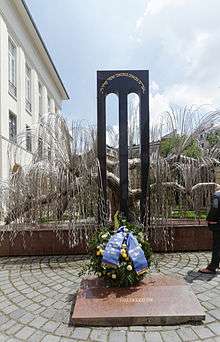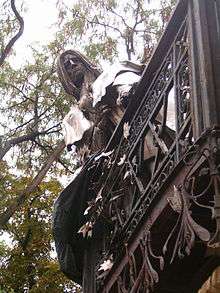Imre Varga
.jpg)
Imre Varga (born 1 November 1923, Siófok) is a Hungarian sculptor, painter, designer and graphic artist.[1] He is regarded as one of Hungary's most important living artists,[2] and he has been called one of the "most skilled sculptors in Hungary."[3]
Biography
Even as a schoolboy, Varga's drawings were exhibited in small exhibitions. He studied aeronautics at the Military Academy in Budapest. During World War II, he served as an officer in the Hungarian Air Force before being taken as a prisoner of war by the United States, returning to Hungary in 1945 when he turned to the visual arts. From 1950 to 1956, Varga studied at the Hungarian Academy of Fine Arts in Budapest under Sándor Mikus and Pál Pátzay, graduating with a degree. Since then, Varga has worked in many different artistic fields. He has made small statues and coins, as well as monumental works for public spaces.

One of his public statues is the Holocaust Memorial, located behind the Dohany Street Synagogue in Budapest's Jewish Quarter District VII. The memorial is constructed in the shape of a weeping willow tree, with names of Hungarian Holocaust victims on the leaves.[4]
Another well-visited work by Varga is his group of worried-looking women with umbrellas permanently located in a square in Óbuda, Budapest near the Imre Varga Collection of his work.[1]
He attended the first "Hungarian Fine Arts Exhibition", where his work "Iron Workers" was exhibited. His first high-profile work, "Prometheus", was created in 1965. In the 1970s, Varga broke away from the conventional monumentalism usually seen in Communist countries. He created a wide array of works - ranging from statues of Vladimir Lenin to the Holocaust, to statues of Francis II Rákóczi, Raoul Wallenberg, Sir Winston Churchill and Béla Bartók to Konrad Adenauer and Charles de Gaulle. About 300 of his works are now exhibited in nine countries.
References
- 1 2 "Imre Varga Collection". Lonely Planet. Retrieved 19 November 2014.
- ↑ Steves, Rick (2011), Rick Steves' Budapest, Avalon Travel, p. 84, ISBN 9781598807714.
- ↑ Lajos, Németh (1992). "Responsibility of the Architect". PERIODICA POLYTECHNICA SER. ARCHITECTURE. 36: 142.
- ↑ Steinberg, Phyllis (November 28, 2012). "Budapest has thriving Jewish community". Sun Sentinel. Retrieved 19 November 2014.
| Wikimedia Commons has media related to Imre Varga. |
Additional reading
- Márta Harangozó; Imre Varga; Bálint Ördögh; Judit Ruska (2003), The world of Imre Varga, Kossuth, ISBN 9789630945066.
